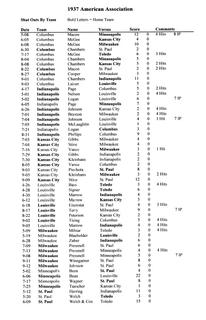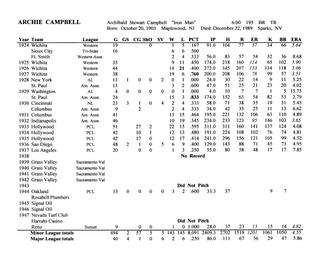Oscar Jones, 2As the years passed, not much more came to light on Oscar Jones. From 1978 through 1992, the Society for American Baseball Research published three volumes of
Minor League Stars, and Oscar Jones did not appear in any of the editions, primarily because the extent of his minor league career had not been discovered, and also what was known had not been fleshed out. And that remains true— to an extent— to this day.
Then, in 1994, Baseball America published the
Minor League Resister, edited by Lloyd Johnson. In working on pitchers, the editors discovered that Oscar Jones had won 229 games, and that merited insertion in the book. (In what I have stumbled across since then, I have brought Jones up to 237 wins, and still counting.) Additionally, they didn’t have his record for his first season in the Montana State League, or his record for the 1911 San Joaquin Valley League. (A curiosity of the 1911 SJV league is that they played on Saturdays and Sundays, but only the Sunday games counted in the standings, and Jones pitched a number of games on Saturdays.) The editors had no listing of where he pitched in 1912, either, which still remains a mystery.
The
Minor League Register picks up Jones’ career in 1900 with Great Falls in the Montana State League, and carries it through the 1913 California State League season, where he goes 24-8 to ending his career. I think most players don’t end their careers on such a high note, and, consequently, I believe there is a good chance I will stumble across another season or two for him.
The
Minor League Register doesn’t list Jones as having pitched in the 1900 California League. My 1900 research on the California League shows him pitching in that league before moving on to the Montana State League. But I pick him up earlier than that. He actually started the 1900 season with Hanford in the San Joaquin Valley League. So far, that the earliest I have been able to push back his career. I checked the box scores I have for the 1899 SJV League, and the only Jones I have is an early-season, one-game third baseman who played for Tulare, and I doubt that that is our man.
In 2002 and 2003, when I was working hard on finishing my Coast League Cyclopedia, the Big Mac of the PCL, I had access to the “Inactive File” of the Association of Professional Baseball Players of America, and in going through those files looking for any information on players whom I had no information on, but who had been Association members.
This is the point where I get involved with Oscar Jones. I never had much interest in Oscar Jones up to that point, but in going through the Association cards, I happened upon one for Oscar Jones, and it caught my eye that he had a different middle name on his card that the one I had listed in my workbook that I carried around when doing research. Flipping the card over, I immediately saw that the list of teams he played for definitely proved it to be Oscar Jones who played in the Coast league and for Brooklyn as those two clubs were listed. Also on the card of Oscar Lafayette Jones was a different birth place and birth date: October 22, 1879 at Salem, Missouri. In further research in the files, done by Dick Beverage, we were able to find Association addresses for Jones in the Central Valley, Los Angeles, and, finally, in Dallas, Texas. Several of which were, I believe, Goodyear Tire dealerships. At some point after that, Peter Morris got involved and tracked down an obit in Texas, after checking “possibles” on the Texas Death Index, and then birth information was confirmed in Missouri. The SABR Biographical Committee list Jones as having been born in Carter County, MO, but I have chosen to leave Salem, MO as his birth place, because that was the closest town to the farm where he was born. One must remember two things about that period: 1) People were born at home; 2) That the United States was a rural country where most people were born in the farmhouse on a farm. If one were born, say, two miles out of town, they would technically have been born in the county rather than the town, but most people of the time would say— and believe— that they were “from” the closest population center. If Oscar Jones himself wanted to be from Salem, MO, that’s good enough for me.
(One strange thing that came up when he first pitched in the California League is that they called him in the San Francisco papers “the Hanford boy.” I wonder if they just didn’t know much about him, and made the assumption he was from there— or that he was really from there in the sense at he had lived there for some time. Next time I’m up at the State Library, I’ll go through the Hanford paper to see if I can dig anything else up on him. For now, it remains a mystery how Oscar Jones began his career in Hanford, California. Or did he? Could he have pitched himself west in 1899?)
In one other area, I have problems with the encyclopedias: Oscar Jones’ height and weight. He was built like a fireplug, one of pure muscle. I have seen his height and weight referred to time and again in small-town California papers as being 5:06 and 175 lbs. The reason that this was important for the papers is that virtually every year teams wound have a running race as a draw for fans, and invariable Oscar Jones would win the race. Obviously, if you are 5:06 and 175 lbs. and are the fastest man on the team— that is news, and, of course, papers made mention of it. The encyclopedias list Jones at 5:07 and 163. Because he played early in his career with Brooklyn, it’s possible that his weight was 163 at the time, but he didn’t shrink an inch in the Coast League, so I’m sticking with the 5:06 figure.
In the next couple of years, with my work on documenting professional baseball leagues in the state of California, I hope to be able to put together a pretty good career record for Oscar Lafayette Jones.





















